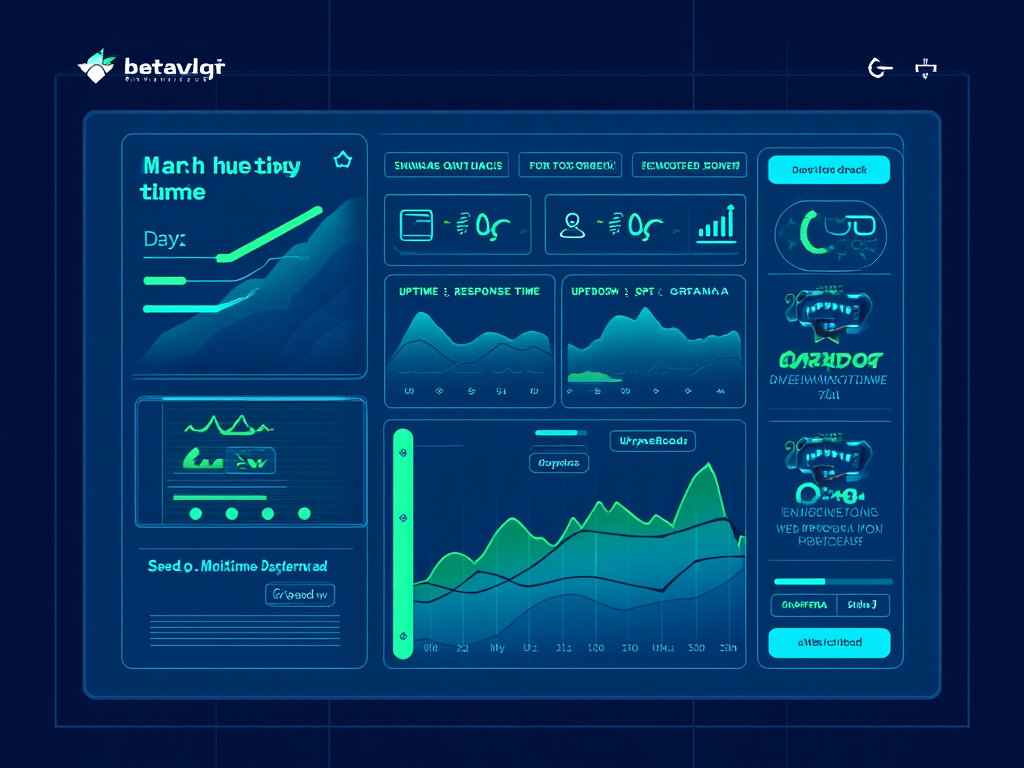How to troubleshoot downtime problems with your host
შესავალი
The online world is a fickle friend. One moment, your website shines like a beacon, inviting users to engage, and the next—poof! It's down, leaving silence in its wake. Recognizing how to troubleshoot downtime problems with your host is not just a skill but a lifeline for businesses navigating the vast digital waters. Each minute of downtime can mean lost revenue, frayed customer relationships, and tarnished reputations. Let’s break down how to tackle this disheartening challenge head-on, leaving no stone unturned.
Understanding Downtime and its Implications
Before diving into solutions, let’s familiarize ourselves with the types of downtime. It can occur due to server issues, network failures, or even software conflicts. Each has its fingerprints, and knowing what to look for can save every second counts. How often does your site go down, and for how long? Begin keeping a log; this knowledge will be your compass as you navigate troubleshooting.
1. Identify the Source of the Downtime
The first step is to pinpoint the culprit.
-
Hosting Status: Reach out to your hosting provider. They often have status pages where real-time updates can shed light on wider issues affecting multiple users. Think of it as checking the weather before heading out; you wouldn't want to be caught in a storm without an umbrella.
-
მონიტორინგის ინსტრუმენტები: There’s no shortage of handy tools such as Pingdom or UptimeRobot that alert you the moment your site goes offline. Imagine having a set of vigilant sentinels watching over your digital domain, ensuring you're notified instantly if disaster strikes.
-
Network Check: Consider your own network. Does your Wi-Fi detour at times? Try accessing your site from different devices. A refreshing perspective can reveal variables you've overlooked.
2. Basic Network and Hardware Checks
Once you've looped in your host and checked your tools, it's time to inspect your home setup:
-
Hardware Connections: Dust off your modem and router. Inspect cables and connections. Unbeknownst to many, a loose cable could be the villain of the story, pulling your website into the abyss.
-
Power Cycle: Your devices occasionally need a break, too. A simple reset of your internet hardware can sometimes work wonders, lifting the heaviness clouding your connection.
3. Software and Configuration Issues
Now, let’s delve deeper into your site’s software:
-
Plugin and Theme Conflicts: If you're running CMS platforms like WordPress, one rogue plugin or a faulty theme update might be sabotaging your site. Disable any recent additions, and reactivate them like old friends, one at a time, to see who draws the ire of the website gods.
-
Error Logs: Dive into your server and application error logs. They resemble a diary of your website's troubles. Spotting an error message might lead you right to the issue—think of it as readings from the fortune teller, revealing future calamities if ignored.
4. Investigate Server-Side Problems
If the previous checks yield no light at the end of the tunnel, it’s time to search the nooks and crannies of your server:
-
Resource Exhaustion: Is your server essentially gasping for air? Too much traffic or unoptimized code can cause this. If your site crawls like molasses before crashing, it's time to revamp your plan or optimize your code for speed.
-
Hardware Failures: It’s not just the software that can break down. An overheating CPU or a failing hard drive can send your site into the void. Encourage your provider to run a thorough check.
-
Software Bugs: Recently imported code or poorly managed databases can also spell doom. Test each segment and keep backups. They’re your safety net.
5. Run Security Checks
Security is not just a box to tick; it’s your first line of defense:
-
Scan for Malware: Take the necessary precautions and scan your site for malicious code. It doesn’t just disrupt accessibility; it can redirect unsuspecting visitors to unholy places. Employ tools from reputable security plugins that promise thorough scans—build those digital walls high!
-
Review Changes: Introduced new code recently? If so, revert back temporarily to pinpoint if these changes were the spark igniting the flame.
6. Content Delivery Networks (CDNs) and Domain Registrar Management
While ideally, your site is fully up 24/7, having strategies in place helps mitigate the chaos:
-
Utilize CDNs: Think of CDNs as your website’s distributed safety net—backing you up across various servers around the globe. They make your site faster while offering redundancy, so if one path leads to a dead end, others might still unfurl for your clients.
-
Domain Management: Keep your domain name alive with proper management. Expiry can lead to the dreaded “site not found” glitches, leaving visitors gasping in confusion.
7. Seek Professional Support
Sometimes solitude isn’t strength. If you’re still hanging by a thread:
-
Rely on your hosting provider's tech support. Equipped with precise details from your analysis, you illuminate the path toward resolution.
-
Get experts onboard—coders or website professionals can rescue you from the depths of server despair, unraveling issues that might be tickling the back of your brain.
Embracing Prevention and Continuous Improvement
As the curtain draws on this first act, bear in mind that downtime shouldn't close the chapter on your website’s success. Proactive maintenance is your best ally. Frequent monitoring, backed-up historical logs, and making informed decisions about server needs are the best defenses against digital tragedy. Each strategy empowers your site’s resilience, ensuring it’s always prepared for whatever storm may come.
By keeping one eye focused on troubleshooting today, you can spend the next moments crafting a strategy to thrive tomorrow. The path is set and filled with opportunity; stay vigilant, and let your website grow into a powerful force.
FINDDOMAIN.GE (შპს ინტერნეტ სერვისები) ძალიან საინტერესო და სწრაფად განვითარებადი IT კომპანიაა. ძირითადი მიმართულებებია: ვებ-განვითარება, დომენები და ვებ-ჰოსტინგი. ის ასევე სთავაზობს კლიენტებს ძირითად სერვისებთან დაკავშირებულ ქვე-მომსახურებას და აუთსორსინგს.
საუკეთესო შეთავაზებები:
გსურთ შექმნათ თქვენი საკუთარი კომპანიის ვებსაიტი ან შექმნათ თქვენი საკუთარი ონლაინ ბიზნესი ინტერნეტში?
– ვებ ჰოსტინგი
– დომენის რეგისტრაცია
– ვებ-განვითარება
– საიტის შემქმნელი



Implementing Preventative Measures
Having navigated the turbulent waters of troubleshooting, it's crucial to shift gears toward prevention. Think of proactive strategies as a seatbelt for your website, ensuring it remains safe during potential bumps in the road. Here’s how to safeguard your digital presence effectively.
1. Regular Backups
Set up a consistent backup plan to keep your data secure from potential failures or attacks. Automated backups can save you not just time but also mental energy. Think of it like having a spare tire—there when you need it but probably forgotten until an emergency strikes. Look for hosts that offer seamless backup solutions integrated into their packages.
2. Consistent Performance Monitoring
Make it a habit to monitor your site’s performance continuously. Leverage tools like Google Analytics or New Relic to identify behavior trends. This vigilance allows you to catch abnormalities—like a sudden spike in load times—before they evolve into full-blown downtime. Would you wait until your car's engine fails before getting an oil change? Regular checks keep your website humming.
3. Optimize Your Infrastructure
Tailor your hosting plan to fit your website’s needs. If your traffic increases, don’t hesitate to upgrade to methods that fit your growing audience's demands. A shared hosting plan might suffice at first, but as your site expands, transitioning to VPS or dedicated hosting can provide the resources necessary to prevent crashes. Make sure your infrastructure keeps pace with your ambitions.
4. Select a Reliable Hosting Provider
A reliable hosting provider is worth its weight in gold. When choosing one, prioritize uptime guarantees, proactive support, and robust infrastructure. Remember, your hosting partner is a critical cog in your website’s machinery, so look for one that’s known for their reliability. Reviews and recommendations from peers in your industry can guide you to those who can meet your needs best.
Incorporating a Recovery Plan
Despite all preparations, outages can still occur. It’s not about avoiding all disruptions; it’s about how you recover when they happen. That’s where an articulated recovery plan becomes your lifeline.
1. Document Recovery Procedures
Write down the exact steps to follow when your site goes down. Each team member should know their responsibilities, from contacting the hosting provider to implementing the recovery strategy. Practicing this plan periodically will make it familiar, almost like a fire drill for your online presence.
2. Ensure Communication Channels are Open
When your site goes down, timely communication is key. Keep your customers informed about the status of the site through social media or email updates. Transparency can mitigate frustration; instead of leaving users in the dark, illuminate them with progress updates, letting them know their patience is valued.
3. Create a Post-Incident Review Process
After a downtime event, conduct a thorough review. What happened? What went well during recovery? What could have been improved? This reflective practice cultivates a culture of continuous improvement, enhancing your site’s resilience against future challenges. Consider creating a checklist of key points to assess—this can help you pinpoint the specifics without missing critical details.
Scaling for Success
To further bolster your defenses, ensure your hosting environment can scale seamlessly as you grow. Here’s what to keep at the forefront of your strategy:
1. Consider Cloud Solutions
Cloud hosting offers a level of flexibility that traditional hosting cannot. With cloud services, scaling your resources up or down can happen almost instantaneously. You shift assets based on current traffic, ensuring optimal performance without resource waste. Isn't it comforting to know your site can adapt as quickly as your business changes?
2. Test Your Resilience
Conduct stress tests on your website. This proactive approach can expose weaknesses in your hosting environment. Simulate increased traffic volumes or unexpected spikes, providing valuable insights into how your site behaves under pressure. Understanding how many users your site can handle before it shakes enables you to prepare better for real-life scenarios.
Final Reflections
Ultimately, while downtime can disrupt the digital experience, the right strategies and practices can significantly mitigate these risks. From robust troubleshooting techniques to structured recovery plans and proactive measures, each step fortifies your online presence.
As you embrace these practices, envision your website less as a risk-laden venture and more as a thriving, reliable nexus for your audience. Your ability to tackle downtime and prevent future disruptions will not only keep users engaged but will also instill confidence in your brand.
Videos that further explore website uptime and recovery strategies:
- How to Monitor Your Website's Uptime Effectively
- Troubleshooting Your Website: Getting Started
- Creating an Effective Backup Strategy for Websites
By implementing these guidelines, you can not only reactivate your site while facing unexpected challenges but also cultivate resilience that promises an enduring legacy in the digital landscape.
FINDDOMAIN.GE (შპს ინტერნეტ სერვისები) ძალიან საინტერესო და სწრაფად განვითარებადი IT კომპანიაა. ძირითადი მიმართულებებია: ვებ-განვითარება, დომენები და ვებ-ჰოსტინგი. ის ასევე სთავაზობს კლიენტებს ძირითად სერვისებთან დაკავშირებულ ქვე-მომსახურებას და აუთსორსინგს.
საუკეთესო შეთავაზებები:
გსურთ შექმნათ თქვენი საკუთარი კომპანიის ვებსაიტი ან შექმნათ თქვენი საკუთარი ონლაინ ბიზნესი ინტერნეტში?
– ვებ ჰოსტინგი
– დომენის რეგისტრაცია
– ვებ-განვითარება
– საიტის შემქმნელი








